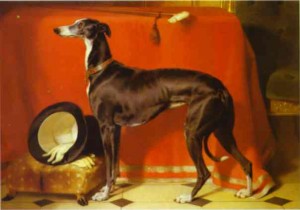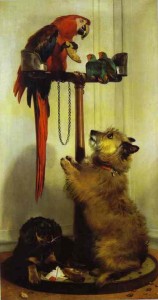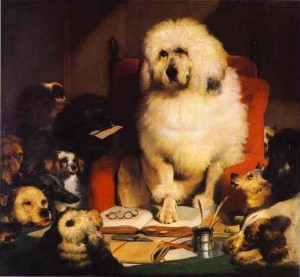For Thursday Art – You have to love Landseer’s dogs.
Eos, A Favorite Greyhound, The Property Of H. R. H. Prince Albert. Sir Edwin Landseer, UK 1841
“A person can learn a lot from a dog, even a loopy one like ours. Marley taught me about living each day with unbridled exuberance and joy, about seizing the moment and following your heart. He taught me to appreciate the simple things-a walk in the woods, a fresh snowfall, a nap in a shaft of winter sunlight. And as he grew old and achy, he taught me about optimism in the face of adversity. Mostly, he taught me about friendship and selflessness and, above all else, unwavering loyalty.”
~John Grogan, Marley and Me: Life and Love With the World’s Worst Dog
Macaw, Love Birds, Terrier, And Spaniel Puppies, Belonging To Her Majesty. Sir Edwin Landseer, UK 1839
“The better I get to know men, the more I find myself loving dogs.” ~Charles de Gaulle
Laying Down The Law. Sir Edwin Landseer, UK 1840
“The average dog is a nicer person than the average person.” ~ Andy Rooney
High Life. Sir Edwin Landseer, UK 1829
“No matter how close we are to another person, few human relationships are as free from strife, disagreement, and frustration as is the relationship you have with a good dog. Few human beings give of themselves to another as a dog gives of itself. I also suspect that we cherish dogs because their unblemished souls make us wish – consciously or unconsciously – that we were as innocent as they are, and make us yearn for a place where innocence is universal and where the meanness, the betrayals, and the cruelties of this world are unknown.” ~Dean Koontz, A Big Little Life: A Memoir of a Joyful Dog
The Old Shepherd’s Chief Mourner. Sir Edwin Landseer, UK 1837
“Everything I know, I learned from dogs.” ~ Nora Roberts, The Search
Dog quotes from www.goodreads.com
Sir Edwin Henry Landseer, RA (7 March 1802 – 1 October 1873) was an English painter, well known for his paintings of animals—particularly horses, dogs and stags. The best known of Landseer’s works, however, are sculptures: the lions in Trafalgar Square, London.
Landseer was born in London, the son of the engraver John Landseer A.R.A… He was something of a prodigy whose artistic talents were recognised early on. He studied under several artists, including his father, and the history painter Benjamin Robert Haydon, who encouraged the young Landseer to perform dissections in order to fully understand animal musculature and skeletal structure. Landseer’s life was entwined with the Royal Academy. At the age of just 13, in 1815, he exhibited works there. He was elected an Associate at the age of 24, and an Academician five years later in 1831. He was knighted in 1850, and although elected President in 1866 he declined the invitation.
In his late 30s Landseer suffered what is now believed to be a substantial nervous breakdown, and for the rest of his life was troubled by recurring bouts of melancholy, hypochondria, and depression, often aggravated by alcohol and drug use.
So popular and influential were Landseer’s paintings of dogs in the service of humanity that the name Landseer came to be the official name for the variety of Newfoundland dog that, rather than being black or mostly black, features a mix of both black and white; it was this variety Landseer popularised in his paintings celebrating Newfoundlands as water rescue dogs, with the appealing idea of noble animals devoted to humankind—a devotion indicated, in Saved, by the fact the dog has rescued the child without any apparent human involvement. Landseer was rumoured to be able to paint with both hands at the same time, for example, paint a horse’s head with the right and its tail with the left, simultaneously. He was also known to be able to paint extremely quickly—when the mood struck him. He could also procrastinate, sometimes for years, over certain commissions.
Landseer’s death on 1 October 1873 was widely marked in England: shops and houses lowered their blinds, flags flew at half-staff, his bronze lions at the base of Nelson’s column were hung with wreaths, and large crowds lined the streets to watch his funeral cortege pass.Landseer was buried in St Paul’s Cathedral, London.
Landseer information from: http://en.wikipedia.org/wiki/Edwin_Henry_Landseer





Leave a Reply